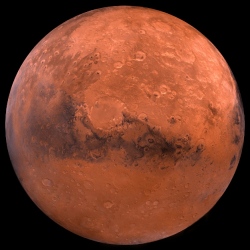
The UCL-made ‘structural-thermal model’ of the ExoMars PanCam instrument for the joint ESA-Roscosmos rover mission leaves UCL Mullard Space Science Laboratory (MSSL) for Airbus UK in Stevenage. This is the first of several steps on the way to Mars – in 2016, UCL will deliver engineering- and flight models.
“It’s exciting to finally be delivering our first hardware”, said Professor Andrew Coates, who leads the international PanCam team as Principal Investigator (UCL MSSL). “Ever since we proposed the instrument in 2003 following the loss of Beagle 2, we have been looking forward to imaging on the surface of Mars, and this is the first tangible step after years of preparation.”
“This has been a huge team effort, with more to come”, said Project manager Craig Leff (UCL MSSL). “Our team at MSSL has led the building and testing of the structural-thermal model, incorporating some hardware from our German and Welsh colleagues as well, which has been useful practice for the real thing. We look forward to the coming year or two and the challenges of producing a tested, calibrated flight model PanCam to send to Mars.”
The purpose of the structural-thermal model is to make sure everything fits together to test computer models of the rover’s thermal environment. This allows changes to be made to help ensure the rover’s survival in the harsh Martian conditions, which can range between just above zero during the day to -100 degrees C at night.
“The temperature on Mars is a particular engineering challenge for PanCam, as it is in an exposed position at the top of the mast, and the external temperature range is very wide, so it’s important that the thermal models are accurate”, said Mr Leff.
“PanCam will be the most powerful scientific camera system sent to Mars yet,” said Professor Coates, “so it’s vital we get it right”. PanCam has 11 filters on filter wheels in front of each of the wide angle cameras. “The geology filters are optimized to detect water bearing minerals including clays, to measure the water vapour and dust in the Mars atmosphere, and the high resolution camera will add texture to the 3D and colour imaging of terrain near the rover,” he added.
PanCam is one of the ExoMars ‘context experiments’ – others include an infrared spectrometer, subsurface sounding radar, a close up imager, a neutron detector and an imager in the drill tip, all of which will help assess the conditions and provide valuable feedback on how the mission should proceed.
“This suite will set the context both above and below ground for the really new and unique thing about this mission – drilling up to 2m under the surface to search for signs of life on Mars,” said Professor Coates.
Samples taken from below the surface will be deposited in an ‘analytical drawer’ and then studied inside the rover body by a Raman spectrometer, an infrared spectrometer and a gas analyser. By measuring samples with this combination of instruments, the team can detect habitable environments and signs of life itself.
Professor Coates added, “3.8 billion years ago, Mars was a very different place, with water flowing on the surface, a protective magnetic field and a thick atmosphere, at the same time life was evolving on Earth. If life evolved then, we may find it.”
